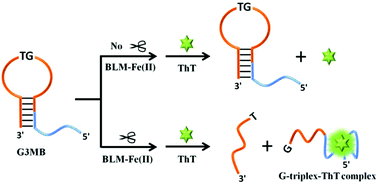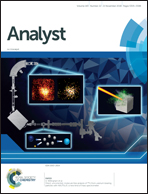A G-triplex based molecular beacon for label-free fluorescence “turn-on” detection of bleomycin†
Abstract
Since bleomycins (BLMs) play a prominent role in the clinical treatment of various cancers, the development of convenient and sensitive detection assays for BLM is of great significance in cancer therapy and related biological mechanism research. Here, taking advantage of the easily controllable and excitation of the G-triplex DNA structure, we reported a facile, label-free G-triplex based functional molecular beacon (G3MB) sensing system for fluorescence “turn-on” detection of BLM based on BLM-Fe(II) mediated DNA strand scission. In the presence of BLM, the stable hairpin structure of G3MB undergoes an irreversible cleavage in the loop region that contains a 5′-GT-3′ recognition site for BLM. The released G-tract DNA fragment self-assembles into a G-triplex–ThT complex showing a strong fluorescence. Owing to the effective locking of G-tracts in the stem of the G3MB and the specific DNA strand scission by BLM which is like a key for the release of G-tracts, the assay shows high sensitivity and selectivity with a detection limit of 0.2 nM. In addition, satisfactory results were obtained for the detection of BLM in human serum samples. Critically, the convenient “mix-and-detect” protocol, fast response and no need for modifying DNA offered a potential application of the proposed strategy for BLM assay in biomedical and clinical studies.



 Please wait while we load your content...
Please wait while we load your content...